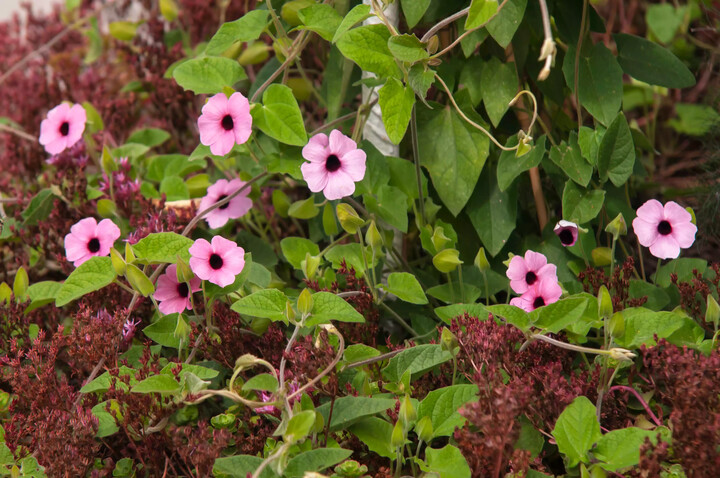The black-eyed Susan vine (Thunbergia alata) is a frequent sight in hanging baskets at the garden center. This flowering vine is as easy to care for as it is charming. The flowers look daisy-like at a distance, with five overlapping, solid-colored petals surround a brownish-purple center tube. The medium green leaves are a little coarse and grow opposite one another—they can be either heart-shaped or have a lance-like arrowhead shape.
This vine is native to eastern Africa and grows as a perennial in tropical climates. It is considered an invasive species in much of the world, including in the state of Hawaii. If you live in plant hardiness zones 10 or 11 and wish to grow black-eyed Susan vine outdoors, check with local authorities to make sure it is not invasive in your area.
This fast-growing vine is best planted in the spring once the soil has warmed. It is most commonly grown as an annual and can extend to 8 feet in one growing season.
Botanical Name: Thunbergia alata
Common Names: Black-eyed Susan vine, clock vine, bright eyes
Plant Type: Perennial flowering vine (usually grown as an annual)
Mature Size :3–8 feet tall, 3–6 feet wide
Sun Exposure: Full sun to part shade
Soil Type: Rich loam, medium moisture, well-draining
Soil pH: 6.8 to 7.7 (slightly acidic to slightly alkaline)
Bloom Time: Summer to fall
Flower Color: Red, orange, yellow, white
Hardiness Zones: 10 to 11 (USDA)
Native Area: Eastern Africa
Toxicity: Non-toxic

Black-Eyed Susan Vine Care
These vines will tangle themselves around the nearest support or spill over planter edges. They are perfect for hanging containers and flow just as easily over walls and raised garden beds. A lattice or metal fence makes a good choice for weaving your vines into a living wall, but these plants will clamber over just about anything—from a mailbox pole to an old tree stump. Black-eyed Susan vines bloom repeatedly from May through fall, and no deadheading (removing spent flowers) is required to keep them in bloom.
With their quick growth habit and sprawling nature, black-eyed Susan vines can overtake nearby plants and consequently are often grown solo. However, a nice option is to mix a black-eyed Susan vine with another vine that will intertwine with it. Morning glories are often used for this purpose, particularly the purple varieties that provide a nice color combination. Purple hyacinth bean is another good choice.
Light
You will get the most flowers and the healthiest plants if you grow your black-eyed Susan vines in full sun (at least six hours of direct sunlight on most days). The exception is in hot, dry climates, where growing the plants in partial afternoon shade is recommended.
Soil
Black-eyed Susan vines like a well-draining soil that is rich in organic matter with a fairly neutral soil pH. It can be helpful to work several inches of compost into the soil before planting.
Water
Although these vines don't like sitting in soggy soil, they also don't like being hot and dry. Aim to keep the soil moderately moist. Mulching around the base of the plants will help to keep the roots cool and moist.
Temperature and Humidity
Black-eyed Susan vines are reliably perennial only in USDA hardiness zones 10 to 11. Thus, in cooler areas, they are usually grown as annuals (removed from the garden after one growing season). But because black-eyed Susan vines are technically perennials (they come back year after year), you can put them in a container and bring them indoors for the winter if you're outside of their hardiness zones. Black-eyed Susan vines grown indoors may flower in the winter if they get ample sun and the temperature doesn't fall below 60 degrees Fahrenheit.
Humidity is usually not an issue for these plants, but they can struggle in very dry conditions, so make sure the soil remains moist.
Fertilizer
Black-eyed Susan vines grow quickly and bloom repeatedly throughout the summer. That means they exert a lot of energy. So they will need a light feeding every four to six weeks with a complete fertilizer to keep them growing well. Plants grown in containers, whether outdoors or as houseplants, should be fed every two to three weeks while the plants are in bloom.
Varieties of Black-Eyed Susan Vine
If you are purchasing nursery plants, you might only find the vines labeled as orange or yellow. However, there are more varieties available if you buy from seed. They include:
'Angel Wings' has white flowers with a hint of fragrance.
'African Sunset' has burgundy centers surrounded by red, ivory, and darker shades of apricot and salmon.
'Spanish Eyes' shows unusual pastel shades of peach and apricot.
'Superstar Orange' has traditional orange petals with a dark center.
'Susie Mix' produces flowers in yellow, orange, and white.
Growing From Seeds
Container-grown plants are fairly easy to find at garden centers, but black-eyed Susan vine also is easy to grow from seed. Seeds can be relatively expensive, but that's because this plant's seed is difficult to collect. You can start seed indoors about six to eight weeks before your projected last frost date or direct-seed in the garden after the danger of frost has passed. Soak the large, hard seeds in water for a day or two before planting.
Black-eyed Susan vines don't like having their roots disturbed, so it helps if you start the seed in peat or paper pots that will biodegrade when planted with the seedling. Plant the seeds about 1/4 inch deep, and expect them to germinate within two to three weeks.
Common Pests/ Diseases
Black-eyed Susan vine isn't prone to many problems, particularly if the plant has plenty of sun, water, and air circulation. However, whiteflies and spider mites can be potential problems, especially during hot weather or if the plant is brought indoors where there is dry heat. Look out for small insects on the plant, as well as leaf and stem damage. Treat any outbreaks quickly with insecticidal soap.